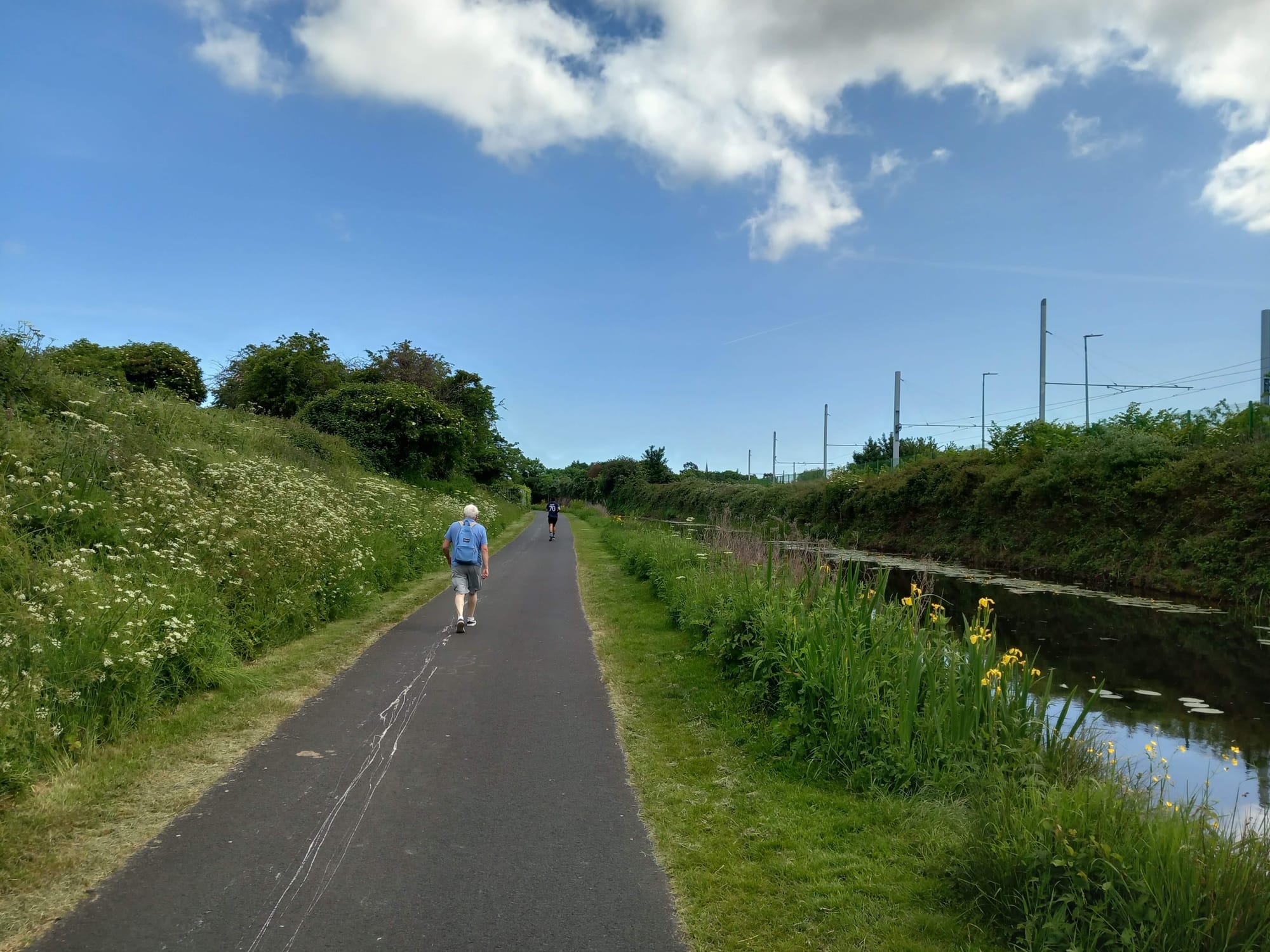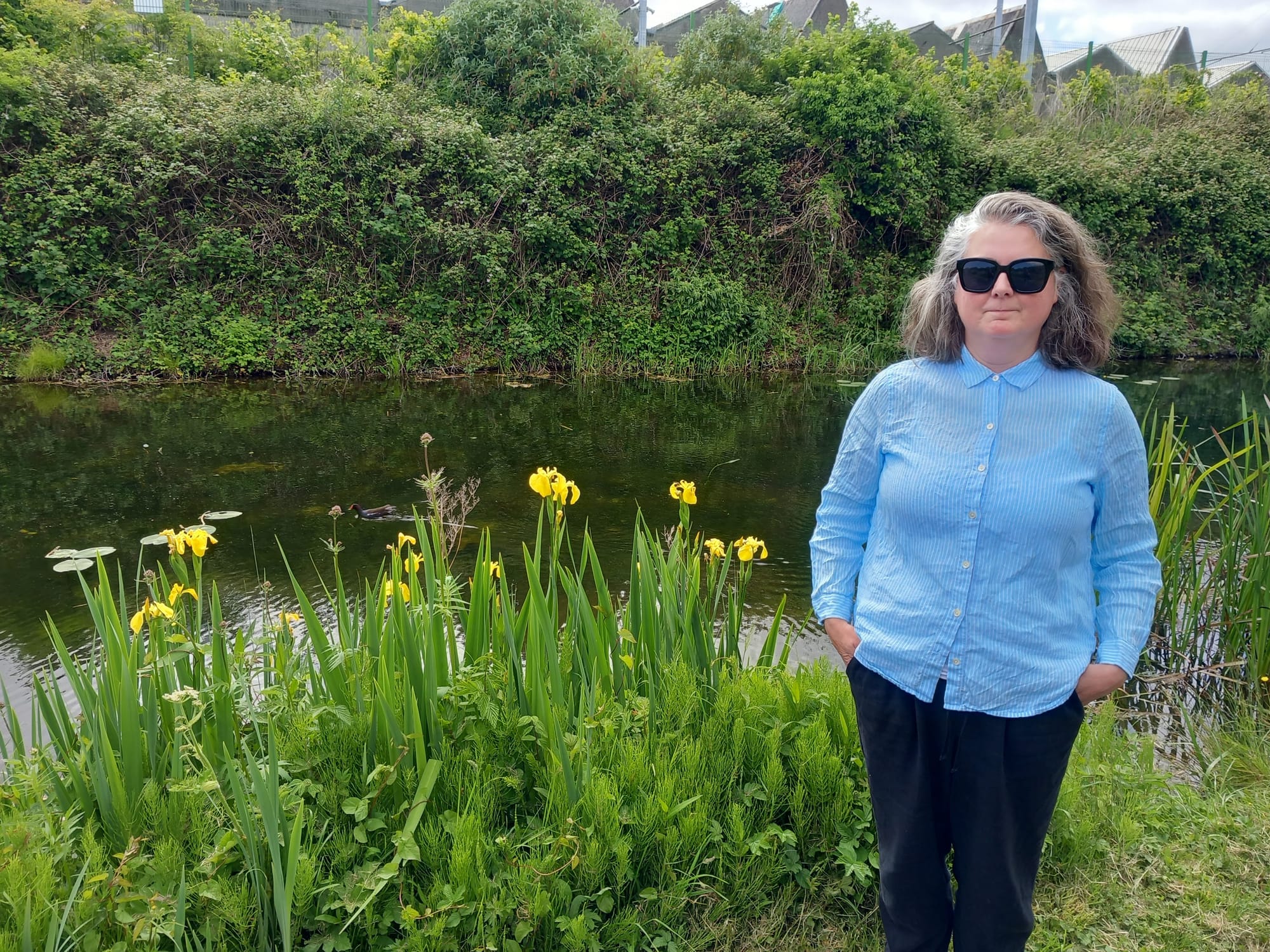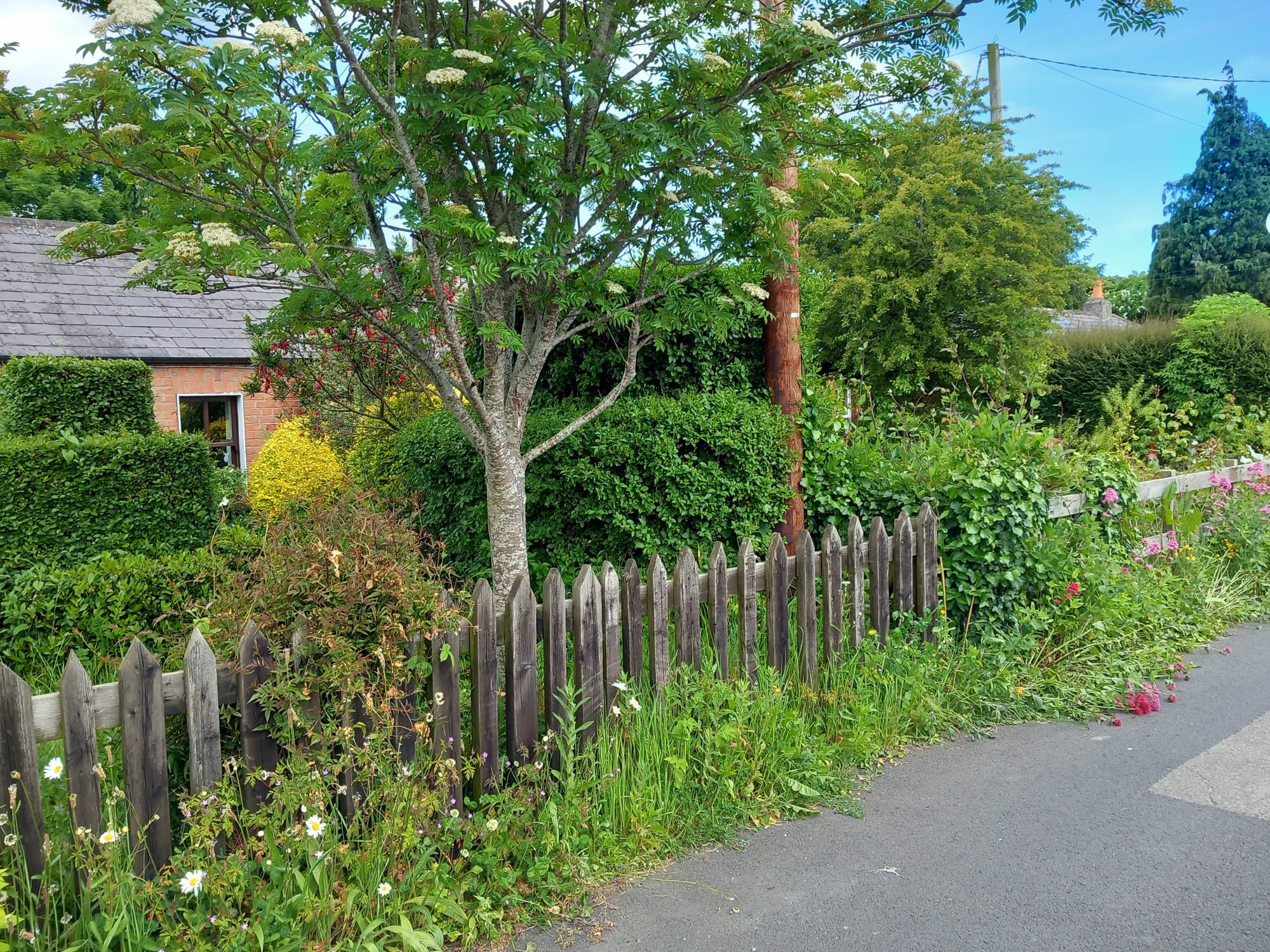What’s the best way to tell area residents about plans for a new asylum shelter nearby?
The government should tell communities directly about plans for new asylum shelters, some activists and politicians say.
“I see photos of greenways across the country and I’m horrified. You get this wide flat surface … and the nature is secondary, and I think, here, it’s worth saving.”

The sun is bright and strong and the sky is a clear blue except for a few fluffs of cloud.
Valerie Vetter, in sunglasses, is walking along the north bank of the Royal Canal from the Crossguns Bridge in Phibsboro, headed west towards Ashtown.
The council plans to remake this segment of the canal as it builds the Royal Canal Greenway – and Vetter is pointing out plants and animals she says will be affected.
Underfoot is a wide paved towpath, to the left a strip of plants and then the canal. Growing there are yellow flag irises, yarrow and tansy, she says.
“These are plants that pollinators love,” says Vetter, who lives nearby, on this Friday 26 May, about 2pm.
There are lily pads floating on the canal’s surface, sprouting yellow flowers, and blazing pink valerian flowers alongside the path.
Birds are flitting about, and Vetter says the area is home to greenfinches, goldfinches, chaffinches and many others – and, at night, there are bats about.
The greenway extends Maynooth to Longford. An effort to extend its eastern end from Maynooth to Spencer Dock in Dublin is underway.
In Dublin city, construction has begun on Phase 3, to the east of the Crossguns Bridge. Now the council is about to put out for public consultation (revised) plans for Phase 4, before councillors vote on whether to start building them.
Vetter and others say the plans seem “over-engineered”, and needlessly destructive of the biodiversity along the canal. They say they hope the pedestrian and cycle path can be improved with less impact on the environment it passes through.
“I see photos of greenways across the country and I’m horrified,” Vetter says. “You get this wide flat surface that’s very well engineered, you could drive a tank over it, and the nature is secondary, and I think, here, it’s worth saving. Could they use a lighter touch?”
Said Kaethe Burt-O’Dea, of Stoneybatter shop and consultancy Bí Urban: “Why have a bicycle highway take over a place that’s very special?”
Dublin City Council has not replied to a query sent on 8 June as to why this whole stretch needs to be upgraded when much of it already has a well-maintained, paved towpath well used by pedestrians and cyclists.


Dublin City Council got planning permission from itself, in a process known as a “Part 8”, back in 2015 for the segment of the Royal Canal Greenway that runs through its territory.
Phases 1 and 2 of the council’s project are done, Phase 3 is under construction, and now the council is working on a revised plan for Phase 4 before building it.
Dublin City Council’s segment of the greenway should link up to Fingal County Council’s, and onwards to the west.
Phase 4 of Dublin City Council’s Royal Canal Greenway project is a 4.2km segment running west from Crossguns Bridge to Ashtown.
As part of the project, the plan is to install ducting under the path for ESB to pull electrical cables through in future.
At a meeting of the council’s Central Area Committee on 9 May, staff presented the details of that plan to councillors and answered their questions.
It’s not clear if any modifications will be made to the plans based on those or other discussions, before the plans are released for public consultation.
The council has not replied to a query sent on 8 June asking for the most up-to-date version of the plans.
It’s also unclear at this stage how much the project might cost.
Phase 3, stretching 2.1km from Newcomen Bridge in North Strand to the Crossguns Bridge in Phibsboro, is supposed to cost about €31 million.
The plan presented to the committee in early May included narrowing three sections of the canal – a combined 1km or so – to make room to widen the path.
The previous plan, according to the council’s Kilian McCrann, had been to leave the canal, on the south side of the path, alone and widen the path by acquiring land on the north side of it.
But, said Eoin Ó Catháín, of engineering consultancy Roughan & O’Donovan, who was also presenting on the project at the meeting, acquiring land takes a long, long time. The council engaged his firm to help design the project.
The last effort to acquire land through a compulsory purchase order (CPO) that he was involved in began about five years ago and hasn’t concluded yet, Ó Cátháin said.
It involved preparing the application for a CPO, sending it to An Bord Pleanála, waiting for a decision, then waiting for a judicial review of that decision, he said.
Labour Councillor Declan Meenagh, speaking by phone on 6 June, said, “We were told it [CPO-ing land to widen the footpath] could take up to five years, whereas, like, if we vote for this now they can start work in September.”
“Look, An Bord Pleanála’s a disgrace,” Meenagh said. “I think there’s people in it that have worked really hard and are decent [but] now just anything that goes in it’s sort of, you put it in and pray it might come out in three years, it’s utter nonsense.”

At the meeting, McCrann said the plan would be to start construction early next year, and have a 24-month construction process, ending in 2026.
Although the canal will be narrowed in places, there will still be room on the water for two boats to pass each other, Ó Catháin said.
But it’ll involve digging up the strip of wildlife, including those yellow flag irises and much more, between the path and the canal, Vetter says, walking next to the canal that sunny day in late May.
It will also involve disturbing the canal bed in a section that has historical creosote contamination.
At the meeting, Ó Catháin said the team will make a plan to carefully remove that contamination without spreading it.
After walking along the canal with engineers, council staff and other councillors on 6 June, Meenagh, the Labour councillor, explained the plan.
They’re going to dry out sections of the canal with dams, and then dig deep into the dried out canal bed and take out as much material as they need to to make sure they’ve got all the creosote, he said.
“They’ll be very clear that they’ve gotten it all and then they’re going to rebuild,” he said.
There are also bats and hedgerows to protect, Vetter says, walking along the towpath past a young couple picnicking on a blanket in the sun.
A couple of parents go by on big bicycles, with small children on smaller bikes following like ducklings.
Bats don’t like lights, but the plan includes putting in lighting. That makes sense for safety, she says, but “Do you have to have either or?”
Is there a way to put in lighting that doesn’t scare off the bats? she asks. “Some other areas have quite bright LEDs – you’ll just lose all the animals.”
At the meeting, Ó Cátháin talked about cutting back, in some places, the hedgerows that grow between the path and the lands to the north, away from the canal.
The new plan of widening the towpath towards the canal instead of away from it will mean fewer hedgerows will have to be cut back, he said.
“We will certainly be putting back more than we are taking out and it will be put in in a far more managed way than what is there at the minute,” he said.
Said McCrann: “They would be cut back but any areas where they’re cut back they’d be replaced with a native species.”
The replacement of old hedgerows with new ones is problematic on a number of levels, says Alan Moore, secretary of the non-governmental organisation Hedgerows Ireland.
“We don’t have woodlands to speak of in Ireland, so our hedgerows are our single most important landscape feature for biodiversity,” Moore said. The organisation’s website features the slogan: “Hedgerows are Ireland’s rainforests.”
Older hedgerows are typically made up of multiple species of plants, Moore says. New ones typically only include a single species. “Biodiversity richness depends on diversity of plants,” he says.
Newly planted hedgerows can take 40 to 50 years to achieve the values in terms of biodiversity and carbon sequestration that old ones had, Moore said,
“We’re in favour of greenways, but not of the over-engineered versions, with excessive width to the detriment of wildlife,” Moore says.
Ó Catháin said at the meeting that in preparing the designs for Phase 4 of Dublin City Council’s segment of the Royal Canal Greenway, the team had received numerous queries about biodiversity.
“We have had extensive consultation with the National Parks and Wildlife Service and Dublin City Council parks and biodiversity department and we have addressed all the issues raised,” he said.
On the towpath that sunny Friday in late May, three starlings sitting in a tree squawk and squabble and then take off – and fly across the clear blue sky, over the canal.
“I just think it’d be a shame to lose this,” Vetter says, walking along, passing the four Coke Oven Cottages, where people live, their front gardens opening up onto the path.

An older man with grey hair and a blue backpack strides by. A younger man, sweaty, runs past in a black sports jersey, with the number 70 on his back. A cyclist on an electric bike weaves through the pedestrians.
On the phone on 6 June, Meenagh said he was just back from a walk along the path with engineers and council staff and councillors. Why does this well-paved, well-maintained path need to be widened and remade?
“Yes. Some of us would wonder that,” Meenagh says. “In fairness, parts of the path are very good. Parts are less good.”
“When you have a family walking, it can be very hard for cyclists to get past them and I think that people want, like, to not have to slow down. So I think they want to deliver a wider path.”
Green Party Councillor Darcy Lonergan said by email that, “After walking it myself, I think we need to allocate more space for the walkers and cyclists to travel comfortably.”
“It is a bit tight at the moment, especially if you have 2/3 people walking together and a cyclist comes,” Lonergan said. “There are also some areas on the path where the surface needs to be upgraded for safety reasons.”
The plans presented to the Central Area Committee in early May showed images of what the completed path might look like. From them, it’s a bit unclear how well separated the cycle lane would be from the pedestrian path.
But Meenagh, the Labour councillor, says the path will be a shared space for pedestrians, cyclists, people on e-scooters, whatever.
“Unfortunately, like, I was trying to get a segregated path on this, like a safe footpath, and that isn’t happening,” he said. “So it’s all shared – a lot of it is shared space, unfortunately.”
Meenagh is visually impaired and said that, out walking on the footpath, he couldn’t hear bikes approaching. People he was with had to tell him they were coming. “So if I’m on my own, I’m not going to hear the cyclists coming.”
The plans for the revamp of the path, “I mean, I think we’re gonna have to go with them. But I think we need a strategy to slow the bikes down,” Meenagh said.
First, the path should have chicanes, or bends in it, to slow down cyclists. Second, the kissing gates along it shouldn’t be removed entirely – they keep out motorbikes, he said.
“Maybe a wider type of S-shape of gates, where it is possible for a wheelchair but it’s harder to get a full motorbike through,” he said.
The plans will be released to the public for consultation soon, said Lonergan, the Green Party councillor.
“The public consulation will allow for questions and concerns to be brought forward and addressed and in some cases solutions to be formed,” she said.
Yes, there is a climate emergency, and getting more people cycling can help address that, says Burt-O’Dea, of Bí Urban.
But there are often better ways to approach projects if engineers will draw on the community’s knowledge, and listen to their ideas, she said.
“These engineers who are making these spaces don’t know these areas nearly as well as the people who live there,” she said.
Get our latest headlines in one of them, and recommendations for things to do in Dublin in the other.